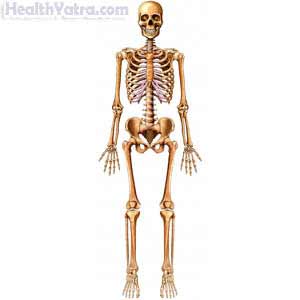تعريف
Osteogenesis imperfecta (OI) is a genetic problem of the bones. The most common effect is weakened bones that break easily. There are at least eight types of OI. Some are mild with no obvious signs, while others are more severe. Treatment plans may also be designed according to the type of OI.

أسباب
OI is caused by a problem in:
- Gene that controls making of collagen—an important element in bones and connective tissues
- Most common cause of OI.
- Most often caused by a random change in the gene. Not often associated with a family history.
- Gene that controls proteins in cartilage
- Less common cause of OI.
- An inherited genetic change from parents. There is often a family history.
عوامل الخطر
A family history of OI may increase your risk of certain types. There are no known risk factors for most types of OI.
الأعراض
In the four most common types of OI, symptoms may include:
- كسور العظام
- فقدان السمع
- Sclera (whites of the eyes) may have a blue, purple, or gray tint
- تشوه العظام
- Short height
- Loose joints and muscle weakness
- Triangular face
- Tendency toward spinal curvature
- Brittle teeth
- مشاكل في التنفس
- Bruising easily
التشخيص
Your doctor will ask about your symptoms and medical history. A physical exam will be done. OI may be diagnosed based on your history of fractures or appearance alone. Your doctor may order tests to confirm the diagnosis. To examine the bones your doctor may order:
- الأشعة السينية
- Bone mineral density test
- خزعة العظام
Your doctor may also want to do genetic testing. This can help determine the type of OI. Genetic testing can be done through a blood, saliva, or skin biopsy.
If you are pregnant and have a family history of OI your doctor may do:
- Ultrasound —to look for skeletal problems before birth (will only show in certain types of OI)
- Chorionic villus sampling (CVS)—for genetic testing
العلاج
There is presently no cure for OI. You and your medical team will create a plan to help you manage OI. In general treatment is directed toward:
- Preventing health problems
- Improving independence and mobility
- Developing bone and muscle strength
Some supportive treatment options include:
- Medication called bisphosphonates—to increase bone mineral density
- Physical therapy—for range of motion and muscular strength exercises
- Surgical implant of rods into long bones—to provide strength and prevent or correct deformities
- Monitoring for development of fractures or scoliosis
- Assistive devices like canes or wheelchairs—may be needed with certain types of OI
Problems related to OI, such as fractures, can be reduced or prevented by a healthy lifestyle. This should include:
- Exercise—swimming is often an ideal and safe activity
- Good nutrition
- لا تدخن
- Avoid drinking excessive amounts of alcohol
الوقاية
OI is caused by a genetic defect. There is no known way to prevent it.
Genetic counseling may be useful if you are planning on having a child and you have OI or a family history of OI. The counselor can let you know the risk your child may have of developing OI.
